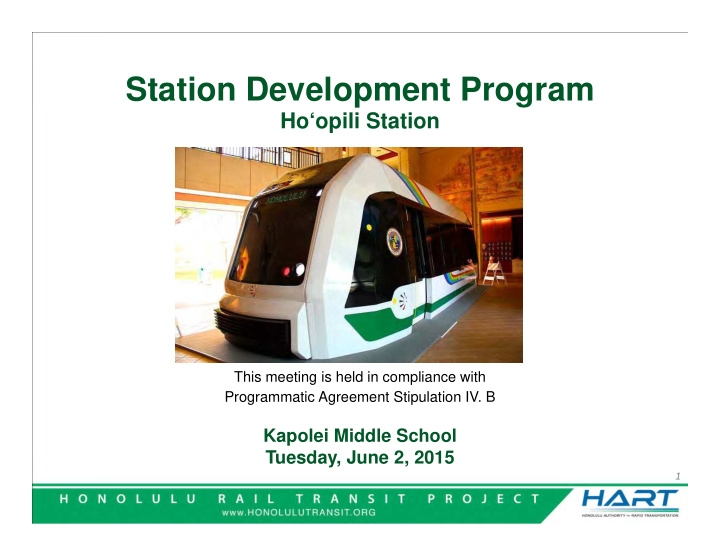



Station Development Program Ho‘opili Station This meeting is held in compliance with Programmatic Agreement Stipulation IV. B Kapolei Middle School Tuesday, June 2, 2015 1
Project Map 20 Miles – 21 Stations WOFH KHG ROC City Center Airport
Features & Operating Details When will trains run? 4 a.m. to midnight Every 5 minutes during peak travel times Every 11 minutes during non-peak travel times How fast will trains travel? 55 mph top speed & 30 mph average including station stops System Features Platform Safety Gates Single systemwide fare system for rail and TheBus ADA compliant Bicycles, surfboards, wheelchairs, strollers, and luggage allowed Free Wi-Fi 3
Features & Operating Details Platform Safety Gates Open Spaces: Breeze Flows Through Rain Protection: Entry to Boarding Colors & Finishes Reflect Hawai‘i Cultural/Historical Motifs & Artwork Landscaping Incorporates Indigenous Plants Hawaiian Station Names System-Wide Security: CCTV in Stations & Vehicles Stair Bike Ramps Bike Stair Ramp Heavy Duty Large Elevators Emergency Response & Generators Bus – Rail Coordination 4
Station Park-and-Ride Facilities Pearl Highlands (1,600 spaces) East Kapolei (900 spaces) Aloha Stadium (600 spaces) UH West O ‘ ahu (1,000 spaces) 5
Ho‘opili Station 6
DR Horton Master Plan Ho‘opili Project Ho ʻ opili Station Waipahu UH West UH West O ʻ ahu O ʻ ahu Station East Kapolei Station 7
8 Ho‘opili Station – Aerial View
Ho‘opili Station Entrance 9
Ho‘opili Station Entrance 10
East Kapolei and University of Hawai‘i West O‘ahu Stations 11
12 East Kapolei Station Entrance
University of Hawai‘i West O‘ahu Station Entrance 13
Cultural Programs 14
Cultural Paving & Landscape Plan Ho‘opili Station Puahala Makaloa Mat pattern — represents the majestic mountains seen from the plain Swirling Ka makani (winds) that flow through Honouliuli Shrubs & Ground Covers Nehe Pohinahina Yellow Hibiscus ‘ Ulu Tree 15
Aesthetic Column Program The history and stories that celebrate the past while acknowledging the present day existence that surrounds each station site... Ho‘opili Station 16
Aesthetic Column Program Ho‘opili Station Columns Honors the natural elements that nourished the agricultural lands and the mo‘olelo of the Honouliuli ahupua‘a 17
18 Aloha Stadium UH West O ʻ ahu Interpretative Signage Program
Station Art Program A selection of flowers and plants used in the lei will be celebrated on each station platform windscreen. Educational interpretative text that highlights the cultural significance or traditions of the plant selection will be included. Windscreen Design 19
Station Art Program Art Opportunity Categories Types of materials • Paving and Floor Designs • Metal • Platform Glass Windscreens • Stone • Wall Murals and Low reliefs • Glass • Grille and Artistic Fencing • Concrete • Art Glass Windows • Ceramic Shad Crossing by Ming Fay Glass mosaic • Attached Architectural Elements • Mosaic tile Delancey Street ‐ Essex Street, MTA, New York City Transit • Other durable materials impervious to environmental conditions See It Split, See It Change , by Doug & Mike Starn, Fused glass panels & stainless steel fence South Ferry Station, 1 line, MTA ‐ New York City Transit 20
Station Naming Program • Ticket Vending Machines (TVMs) • Turnstiles & Wheelchair ADA Access • Neighborhood & Station Locations Map • Customer Information Phones • Emergency Phones • Public Address and Digital Variable Messages • Directional Signage to Platform Station Entry Module • Automated External Defibrillator (AED) All stations will have Hawaiian Language names with location identification. 21
Inspiration and References Design Language Pattern Book “A guide for the station colors, textures, finishes and enhancements” ‐ Design Language Pattern Book “Site conditions, site circumstances, technical issues, budgets and numerous other considerations will shape final design.” ‐ Design Language Pattern Book Authored by Dan Chun, Architect, FAIA Traditional Cultural Properties Study • Examination of the Cultural & Historical records • Wahi Pana (Storied and Sacred Places) • Major Mo‘olelo (legends) and Themes • Identified Inoa ‘ Ā ina (named places) • Create Site Maps to locate Inoa ‘ Ā ina • Identify eligible sites for submittal to National Registry Authored by Kumu Pono Associates, Kepa Maly & Onaona Maly 22
Inspiration and References Archaeological Inventory Survey Reports Account of the Natural Environment • Soils, rainfall, terrain & waterways Historical Background • Political and Cultural • Agricultural • Land use and ownership • Military Mythological and Traditional Accounts • Hawaiian Mo‘olelo (legends) Authored by Cultural Surveys Hawai‘i, Inc. Community Comments – You asked, we listened. Over 300 comments considered – Colors: Incorporate earth tone colors Community Input Report Landscaping: Use indigenous plants 2009 through 2013 History: Interpretive, historical artwork in station tiles Signage: Use Hawaiian and English language 23
Stay Connected 24
Recommend
More recommend